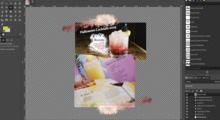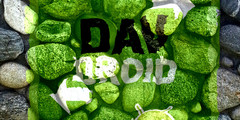time saver?
This discussion is connected to the gimp-user-list.gnome.org mailing list which is provided by the GIMP developers and not related to gimpusers.com.
This is a read-only list on gimpusers.com so this discussion thread is read-only, too.
| time saver? | rmooney | 16 Nov 02:48 |
| time saver? | Liam R E Quin | 16 Nov 02:54 |
| time saver? | Jay Smith | 16 Nov 03:13 |
| time saver? | Jay Smith | 16 Nov 03:21 |
| time saver? | Alex Vergara Gil | 16 Nov 14:20 |
- postings
- 1
time saver?
I enjoy using GIMP, but I'm looking for some help to cut down on my time watermarking my photos. Currently I am opening a photo, adding text, rotating text, duplicating the text layer, then moving each layer to the top left and bottom right corners. Surely there must be a way to make this process quicker? Any help will be appreciated.
time saver?
On Fri, 2012-11-16 at 03:48 +0100, rmooney wrote:
I enjoy using GIMP, but I'm looking for some help to cut down on my time watermarking my photos.
For http://www.fromoldbooks.org/ I use imagemagick to watermark the images, in a little script (for Linux) I'd be happy to share.
Liam
Liam Quin - XML Activity Lead, W3C, http://www.w3.org/People/Quin/ Pictures from old books: http://fromoldbooks.org/ Ankh: irc.sorcery.net irc.gnome.org freenode/#xml
time saver?
On 11/15/2012 09:48 PM, rmooney wrote:
I enjoy using GIMP, but I'm looking for some help to cut down on my time watermarking my photos. Currently I am opening a photo, adding text, rotating text, duplicating the text layer, then moving each layer to the top left and bottom right corners. Surely there must be a way to make this process quicker? Any help will be appreciated.
A few years ago I was using Imagemagick for similar watermarking in an automated batch process. However, at that time there were some bugs (at least on our system) that prevented me from getting exactly what I wanted in terms of text appearance. However, it was _supposed_ to work and seemed to for other people. I suspect it does now (if not then also) and would work now on our more modern o/s.
http://www.imagemagick.org/script/index.php
When I was using it, it was part of a larger process I ran: making multiple scaled JPEGs from single TIFFs, and applying the watermark, all in the same process (without messing up the TIFFs).
We still use Imagemagick for the sizing/scaling to process thousands of images. We use a Perl script wrapper to manage the process of running through hundreds of source directories/folders containing tens of thousands of images, processing only those that are newer in the source than the target, and pushing the results to a matching output directory/folder structure. (Thus any changed image will get reprocessed.) We use a complicated algorithm in the Perl script to decided the min / max size for each output, with max limitations on width and/or height (but maintaining original scale), based on the four target uses and on the physical size of the input object TIFFs (the TIFFs are all scanned at 100% of size (said from a printing perspective) at 300 dpi. The original source objects range from 1x1 inch to 20x20 inches (flatbed scans). The output sizes need to be "sane" to fit in a web page that is "sane" and yet takes advantage of whatever size is available without making the page too wide. The logic and math of this hurts my head; among other things, the differences input and output dpi really warps the math, while you are scaling differently depending upon various rules.
Anyway, it works great and runs like cat with a bell tied to its tail. (I'm a cat person, but that would be fun.) The more RAM and the more processors the better and if you can control (increase) the number of simultaneous processes on your machine, you can make it scream.
If we were to go back to watermarking, of course the watermark needs to be applied _after_ the sizing/scaling, but before saving the JPEG.
You could also set up a "watched folder" type of system into which you could drop the source images and have a 'cron' job that checks and processes the folder however often you want.
Jay
time saver?
On 11/15/2012 10:13 PM, Jay Smith wrote:
On 11/15/2012 09:48 PM, rmooney wrote:
I enjoy using GIMP, but I'm looking for some help to cut down on my time watermarking my photos. Currently I am opening a photo, adding text, rotating
text, duplicating the text layer, then moving each layer to the top left and
bottom right corners. Surely there must be a way to make this process quicker?
Any help will be appreciated.A few years ago I was using Imagemagick for similar watermarking in an automated batch process. However, at that time there were some bugs (at least on our system) that prevented me from getting exactly what I wanted in terms of text appearance. However, it was _supposed_ to work and seemed to for other people. I suspect it does now (if not then also) and would work now on our more modern o/s.
http://www.imagemagick.org/script/index.php
When I was using it, it was part of a larger process I ran: making multiple scaled JPEGs from single TIFFs, and applying the watermark, all in the same process (without messing up the TIFFs).
We still use Imagemagick for the sizing/scaling to process thousands of images. We use a Perl script wrapper to manage the process of running through hundreds of source directories/folders containing tens of thousands of images, processing only those that are newer in the source than the target, and pushing the results to a matching output directory/folder structure. (Thus any changed image will get reprocessed.) We use a complicated algorithm in the Perl script to decided the min / max size for each output, with max limitations on width and/or height (but maintaining original scale), based on the four target uses and on the physical size of the input object TIFFs (the TIFFs are all scanned at 100% of size (said from a printing perspective) at 300 dpi. The original source objects range from 1x1 inch to 20x20 inches (flatbed scans). The output sizes need to be "sane" to fit in a web page that is "sane" and yet takes advantage of whatever size is available without making the page too wide. The logic and math of this hurts my head; among other things, the differences input and output dpi really warps the math, while you are scaling differently depending upon various rules.
Anyway, it works great and runs like cat with a bell tied to its tail. (I'm a cat person, but that would be fun.) The more RAM and the more processors the better and if you can control (increase) the number of simultaneous processes on your machine, you can make it scream.
If we were to go back to watermarking, of course the watermark needs to be applied _after_ the sizing/scaling, but before saving the JPEG.
You could also set up a "watched folder" type of system into which you could drop the source images and have a 'cron' job that checks and processes the folder however often you want.
Jay
One added note: By maintaining separate source (input) and target (output) directory structures you ....
- Will never damage your source files.
- If you want to change the watermark on the existing target files for any reason, you simply change the script doing the watermarking, use 'touch' (or similar) to change the dates of either the source or target files so that the process [a Perl wrapper script] will think the source files are newer, and run it again. All your target files will be recreated with the new & improved watermark.
Suggestion: Never delete your target files as a way to tell the process to recreate them. (Instead, move them aside.) I say this because every year I find one or two source files (out of tens of thousands) that have mysteriously been corrupted (though not accessed according to the file internals), the favorite corruption is that the image turns negative. Stray neutrinos?? Anyway, as long as you have your target files, you can at least have something usable even if your source has become bad. [And another good reason for progressive, non-destructive backups stored off premises.]
Jay
time saver?
There is a script named WaterMark that does this automatically asking you what and where to put the text. Download it from http://registry.gimp.org/node/6703. I took this from the GIMP Cookbook page 356 from the author Juan Manuel Ferreyra It looks like this
Regards
Alex
----- Original Message -----
From: "rmooney"
To:
Cc:
Sent: Thursday, November 15, 2012 9:48 PM
Subject: [Gimp-user] time saver?
I enjoy using GIMP, but I'm looking for some help to cut down on my time watermarking my photos. Currently I am opening a photo, adding text, rotating text, duplicating the text layer, then moving each layer to the top left and bottom right corners. Surely there must be a way to make this process quicker? Any help will be appreciated.
-- rmooney (via www.gimpusers.com/forums) _______________________________________________ gimp-user-list mailing list
gimp-user-list@gnome.org
https://mail.gnome.org/mailman/listinfo/gimp-user-list__________ Información de ESET Smart Security, versión de la base de firmas de virus 7122 (20120509) __________
ESET Smart Security ha comprobado este mensaje.











